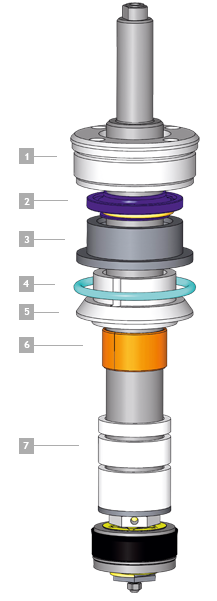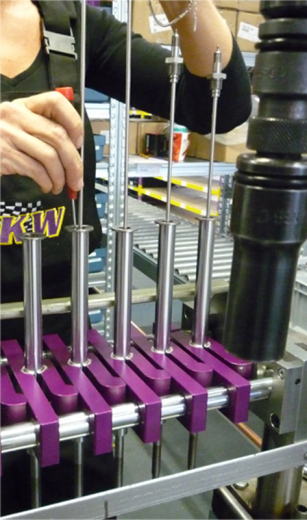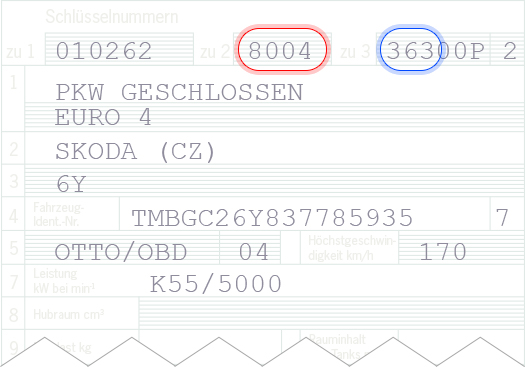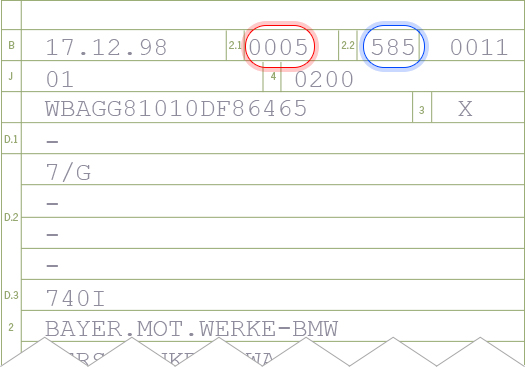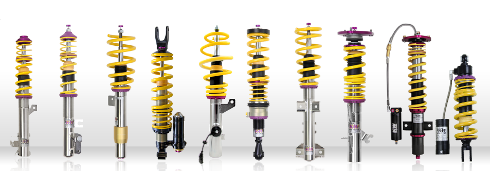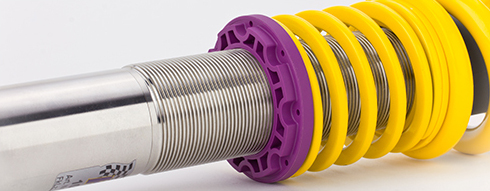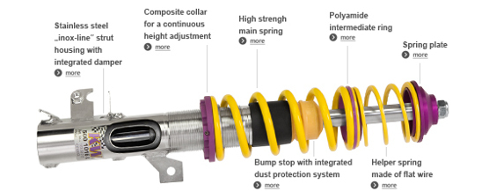
KW V3 damping and valve technology
KW\'s adjustable dampening technology is offered for a wide selection of applications and vehicle class categories.
Damper Basics - The function of a shock absorber
A shock absorbers job is to subside vibrations caused by the wheels, axles, and body. So the technically correct name for it would be a vibration damper. When driving over irregularities, the created shock or vibrations are absorbed by the suspension.
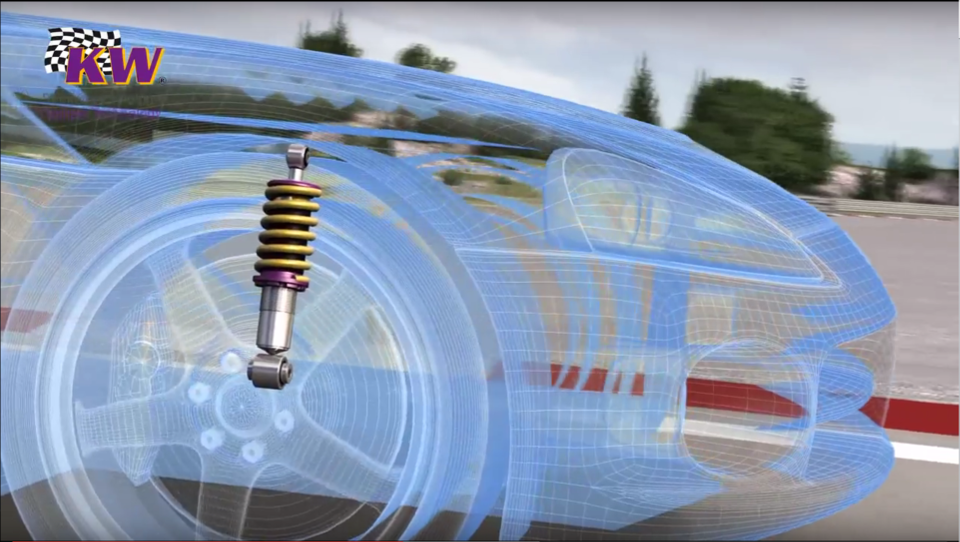
The spring wants to absorb and release stored energy. In a short sequence of these repetitive processes, a vibration arises. These movements are transmitted via the piston rod to the shock absorber. Here the kinetic energy is converted to heat by hydraulic resistance in the shock absorber valve and reduces the vibrations to an inaudible minimum.
An intact shock absorber offers driving comfort and safety and prevents:
- Rocking of the body at successive irregularities
- Gasp or strong immersion during acceleration or braking
- Jumping wheels
- Swerving when braking
- Spinning in corners with a lacking tracking

The shock absorbers used in vehicles are usually twin-tube dampers or mono-tube dampers. A piston moves in an oil-filled cylinder in both damper types. The piston forces the oil through the valves, which creates resistance to the oil flow with the help of various holes and orifices.
How a KW twin-tube shock absorber functions
When a car deflects while driving, the oil which is slightly under pressure, will be displaced by the immersion of the piston rod. It flows into the outer tube through the bottom valve (compression valve) which controls the flow speed. During rebound, the oil flows from the outer tube back into the inner tube. In addition to the channels in the bottom valve, the oil also has to flow through the rebound valve located at the piston rod, to get into the piston housing.
Our KW twin-tube dampers, which we manufacture directly in Germany, are gas-hydraulic or low-gas pressure vibration dampers. During production, we put the damper fluid or damper oil under pressure with up to five bar nitrogen. For this reason, one speaks of a low gas pressure vibration damper. This damper technology, which has also been tried and tested by KW in the aftermarket, is used as original equipment in over 90% of modern vehicles.
The suspension damper converts the kinetic energy of the suspension spring into thermal energy and radiates it to the environment. If a curve is driven, the KW coilover kit works in the inside of the curve of the vehicle in the rebound stage and the KW damper on the outside of the curve in the compression stage.
Rebound adjustment
Independent adjustable rebound damping.
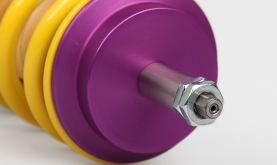
Rebound adjustment by an allen key
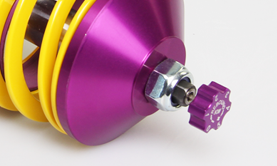
Rebound adjustment by attachable adjustment knob, when space allows
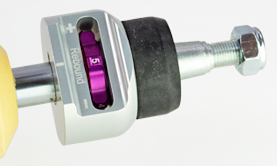
Rebound adjustment by integrated adjustment wheel
What does the rebound stage influence?
The rebound stage has a direct influence on the working speed when rebounding the piston rod and the relaxation rate of the chassis spring. It also regulates, so to speak, how quickly the chassis spring relaxes back to its original position. With different KW coilovers (V2, V3, V4, SC, CS, ...) the driver can adjust the rebound.
So to speak, the diameters of the rebound valves are opened for a smoother ride and closed for a tighter adjustment. With the adjustable rebound stage of the KW coilover kit, the vehicle handling and comfort are influenced.
16 Clicks - Best perfomance and easy adjustment
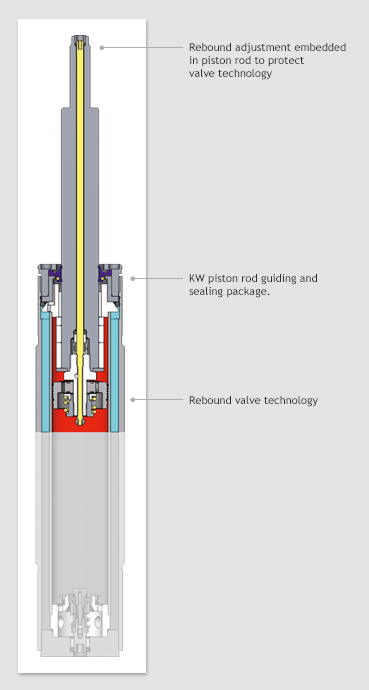
Oil flow during "hard" rebound stroke
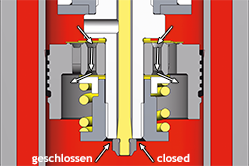
Bypass orifice with closed adjuster position. Digressive damping characteristic and the maximum achievable rebound damping. Damping is determined by the setup specific preload of the valve spring at the piston.
The result:
A firm but not a hard rebound stroke adjustment avoids rolling- and pitching motions.
Oil flow during "soft" rebound stroke
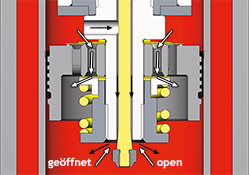
Bypass orifice with open adjuster position allowing for a progressive damping characteristic and ability to achieve minimum possible rebound damping .The bypass oil volume (black arrows) is not available anymore for the spring preloaded valve at the piston and the damping.
The result:
A lower rebound damping increases the driving comfort.
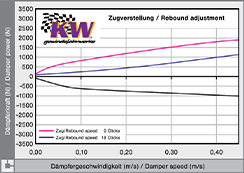
Graphic representation of the relation from damper speed (m/s) to damping force (N) when adjusting the rebound damping.
Compression adjustment
Individually adjustable compression damping
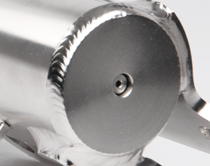
Compression adjustment by an allen key
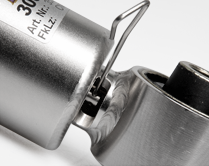
Compression with four hole adjuster, accessible through an opening
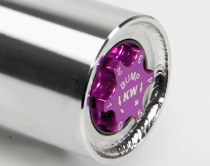
Compression adjustment by use of a integrated adjustment wheel placed at the bottom of the damper
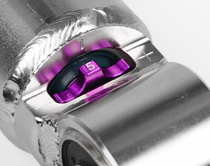
Rebound adjustment by fix integrated adjustment wheel
How does the pressure level affect?
With various KW coilovers (V3, V4, CS, ...) it is also possible to individually adjust the basic setup of the bottom valve via the pressure level click setting. The pressure level regulates the speed of the piston rod when it is immersed. It has a direct effect on the body roll movements and the steering behavior.
If the pressure stage valves are opened, the pressure stage is reduced and the vehicle plunges faster when the steering wheel is turned. If the pressure level is increased, the piston rod plunges more slowly and the more stable the vehicle is when it comes to steering movements. The steering behavior becomes more precise, the more the pressure level is adjusted. With some KW coilovers (V4, CS 3-way, ...) the pressure level can also be set separately in the low and high speed range.
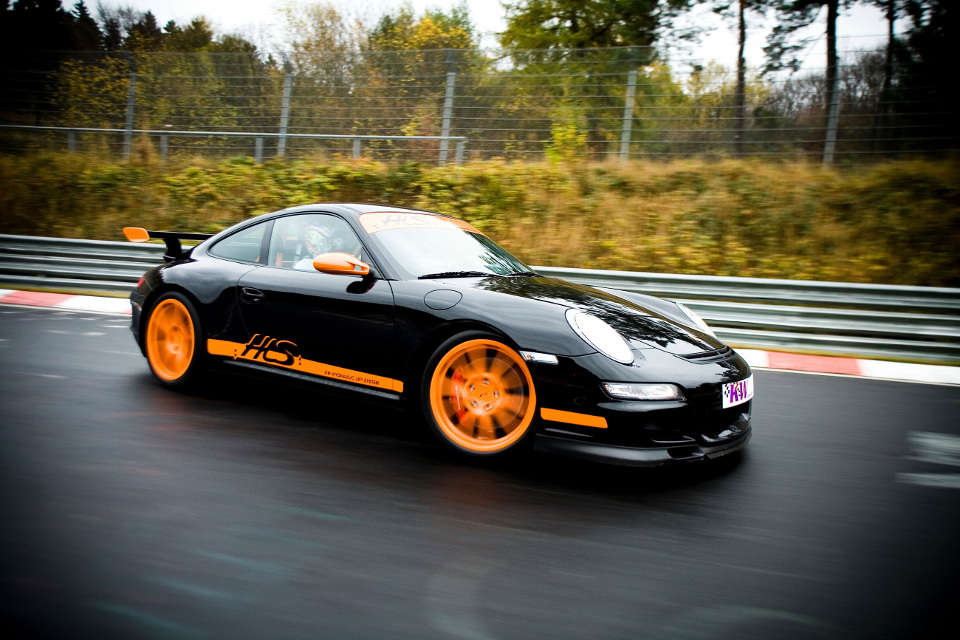
12-way adjustable compression damping with a denounced click feature
The KW Variant 3 and KW Clubsport coilovers are the ideal system for performance orientated driving enthusiasts who value an a wide range of dampening adjustment for their vehicles.
The adjustable independent rebound and compression damping provides an extensive range of damper tuning. This enables the enthusiast to directly effect the turn-in characteristics, tracking stability, trip grip, and handling at the vehicle\'s limits.
The patented KW valve technology for independent rebound and compression damping allows the user to customize their KW damper setup.
Technology of compression damping in detail
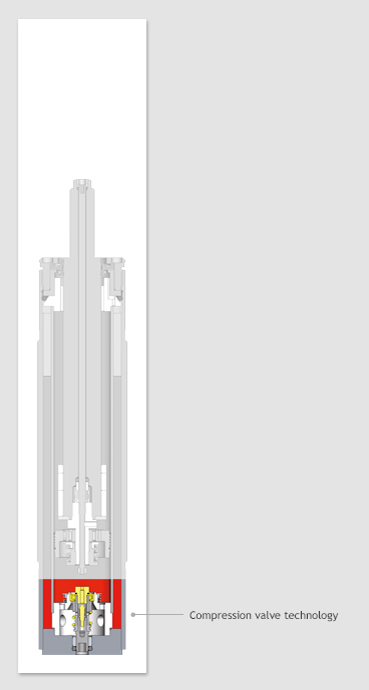
Graphic representation of the relation from damper speed (m/s) to damping force (N) when adjusting the compression damping.
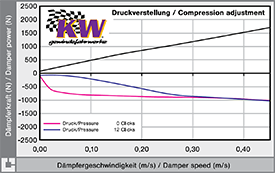
Oil flow during closed compression damping in the bottom valve
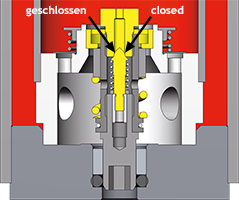
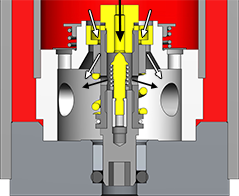
Figure 1:
Spring preloaded bypass valve of compression damping in closed state before compression stroke starts
Figure 2:
Position of the bypass valve with increasing piston rod velocity
During low piston rod velocity (black arrows), oil is flowing over the bypass valve
The high speed compression damping (white arrows) is generated by the spring preloaded sleeve. The closed compression valve generates a progressive characteristic low-speed compression damping graph
The result:
A firmer compression stroke adjustment prevents the vehicle from rolling during cornering
Oil flow during opened compression damping in the bottom valve
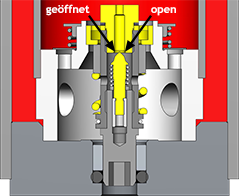
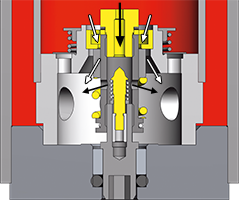
Figure 1:
Spring preloaded bypass compression valve in open state before compression stroke starts
Figure 2:
Position of the bypass valve with increasing piston rod velocity
During slower piston rod velocities (black arrows), oil is flowing over the bypass valve
The high speed compression damping (white arrows) is generated by the spring preloaded sleeve. The opened bypass valve produces a digressive characteristic compression damping graph in Low-Speed ranges
The result:
The Low-Speed damping of this technology enables a consistent high speed compression damping. The (safety-relevant) support of the vehicle during the high speed damping range is not influenced with an opened or closed valve.
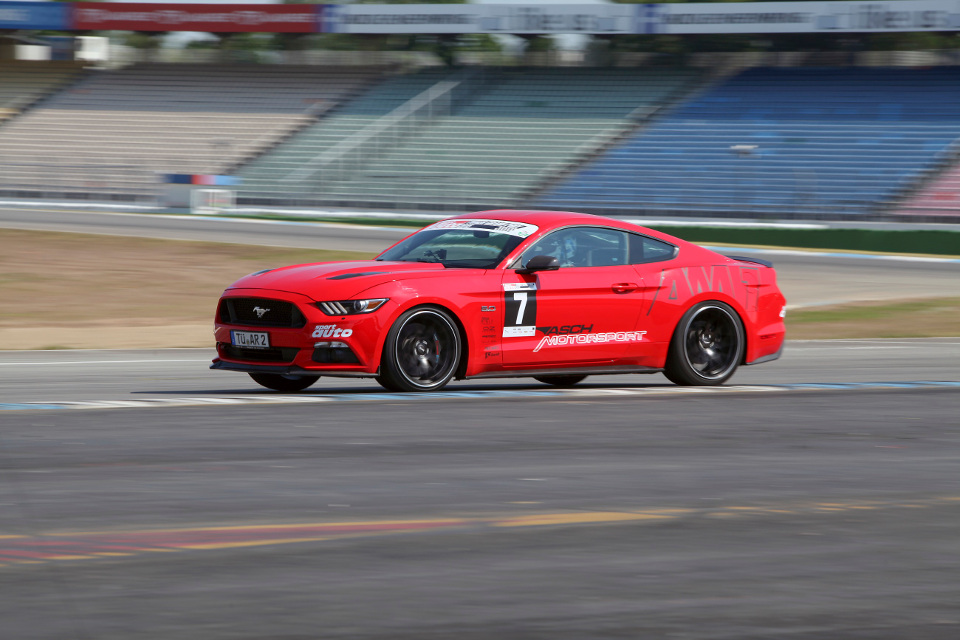
KW piston rod guiding and sealing package
Our modular sealing system exceeds OEM standards. It can be opened easily and allows customized adjustments of the valve technology or rod / piston stroke by an aluminium nut
- High tensile aluminum nut
- Self-lubricated special NBR sealing
- Clamping sleeve
- O-ring made of temperature-resistant viton
- Guide bushing with bleed hole
- Special coated DU plain bearing
- Small increment rebound spacers
